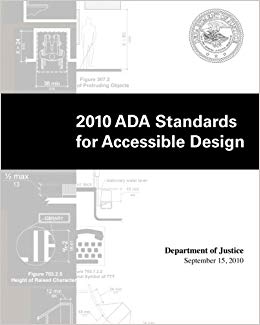ADA Compliance in Industrial Facilities: Know the Facts

6 years, 3 months ago

By Tim Seibert, P.E.
President, Carl A. Nelson & Company
Based on our experience design-building industrial facilities, we know there are a lot of misunderstandings with regard to how the Americans with Disabilities Act (ADA) applies to these facilities.
There are three sections of the ADA regulations. Title I prohibits discrimination against people with disabilities in the workplace. Titles II and III cover the built environment. Title II covers public facilities and services. Title III covers private facilities and services which are categorized as follows:
A Public accommodation is defined as a private entity that owns, operates, leases, or leases to a place of public accommodation. Places of public accommodation include restaurants, hotels, theaters, doctors’ offices, pharmacies, and retail stores, to list a few.
Commercial facilities include office buildings, factories and warehouses, whose operations affect commerce.
Private entities that offer certain examinations and courses related to educational and occupational certification.
Places of public accommodation are required to comply with the ADA plus other things like removing architectural and structural barriers in existing facilities where readily achievable.
The ADA states that commercial facilities are only subject to the requirements for new construction and alterations; not all of the additional requirements for a “place of public accommodation.” Any alterations need to be made so as to ensure that, to the maximum extent feasible, the altered portions of the facility are readily usable by the disabled including the use of wheelchairs.
There is no general exception to the ADA for buildings containing employee work areas that are not accessed by the general public nor based on whether or not a disabled worker could perform the work. Corridors, toilet rooms, kitchenettes and break rooms are not employee work areas.
Common use circulation paths in employee work areas need to comply with the ADA except in work areas less than 1,000 square feet and in areas defined by modular furniture. An accessible means of egress is required from employee work areas in accordance with the International Building Code. Spaces within employee work areas shall be designed and constructed so that individuals with disabilities can approach, enter, and exit the employee work area. Employee work areas, or portions of employee work areas that are less than 300 square feet and elevated seven inches or more above the finish floor where the elevation is essential to the function of the space shall not be required to comply with the ADA.
There are a few exceptions in the ADA that are applicable to certain situations. Spaces accessed only by ladders, catwalks, crawl spaces, or very narrow passageways or spaces frequented only by service personnel for maintenance, repair, or occasional monitoring of equipment are not required to comply with the ADA.
The bottom line is that employee work spaces need to be accessible but that individual work stations do not have to be compliant but may be required to be modified later as a reasonable accommodation under Title I.
The ADA does not require the installation of an elevator in a facility that is less than three stories or has less than 3,000 square feet per story, except in limited circumstances. The elevator exemption does not limit the obligation to comply with the other accessibility requirements even on floors not served by an elevator.
The ADA can be enforced by any authority having jurisdiction or by any person subject to discrimination by civil action including the recovery of attorney’s fees.
In addition to federal ADA requirements, there are state and local building codes and other regulations that can also regulate accessibility. The State Building Code of Iowa states that if you comply with the 2010 ADA Standards for Accessible Design, which would likely be required regardless, you do not need to also comply with the 2015 International Building Code requirements for accessibility. If a local jurisdiction directly adopts (not by adopting the State Building Code of Iowa) a version of the International Building Code without modification, then that code will apply in addition to federal requirements and compliance with both sets of requirements would be necessary.
The requirements in the International Building Code are similar to but not exactly the same as the federal requirements. A noteworthy difference is the International Building Code exception for providing an elevator is only for levels with not more than 3,000 sf and not for less than three stories.
If you need assistance with ADA compliance, we would be pleased to assist you.
ABOUT THE AUTHOR
Tim Seibert, president of Carl A. Nelson & Company, is a professional engineer licensed in the states of Iowa and Illinois. Tim has a BS in Construction Engineering from Iowa State University and an MBA from the University of Illinois-Springfield. Mr. Seibert has 39 years experience in the construction industry and 25 years with Carl A. Nelson & Company. He has completed numerous industrial design-build projects and is considered by many to be a leader in the area of industrial and manufacturing facilities. To learn more, call 319-754-8415, or write to canco@carlanelsonco.com